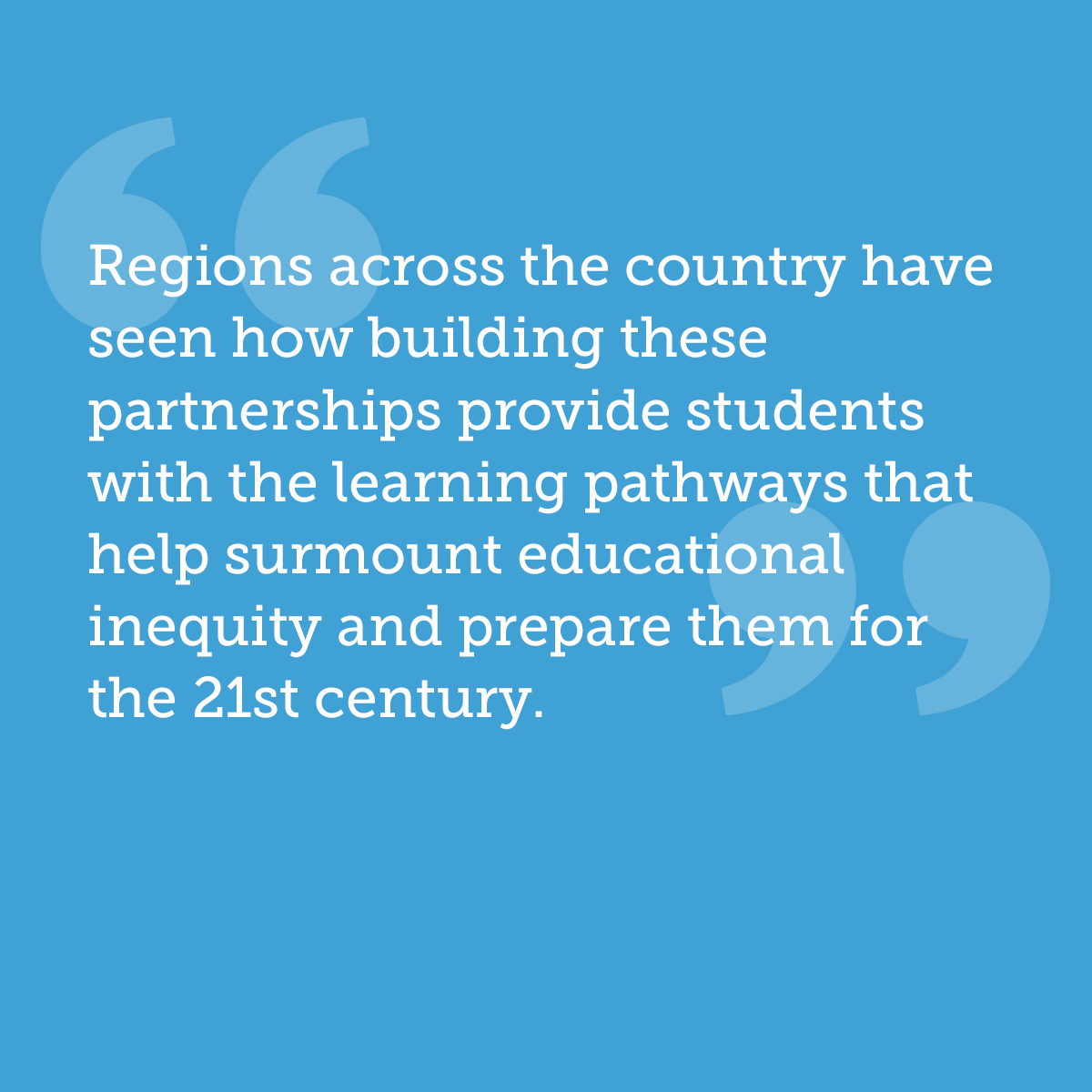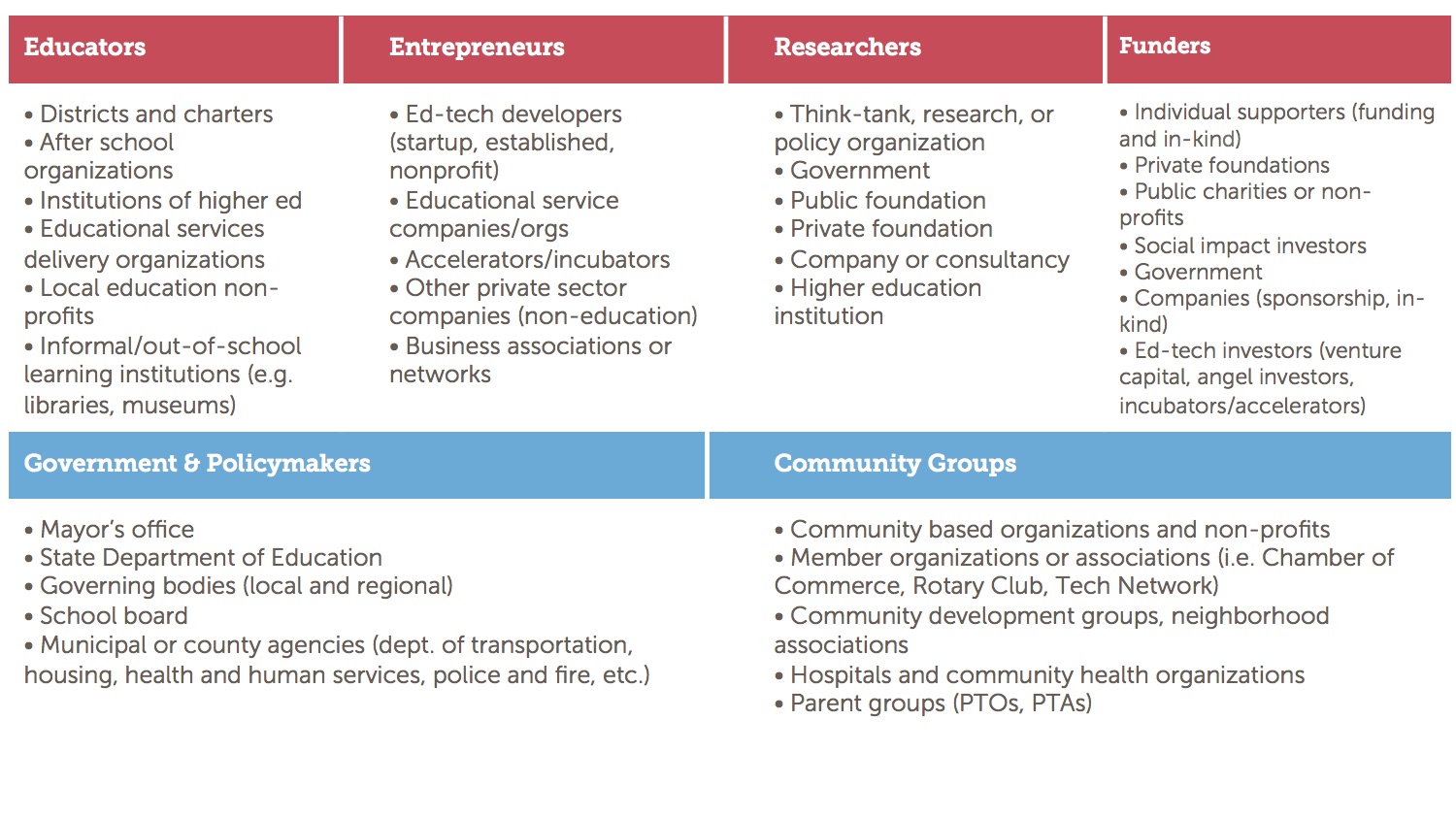
are local communities of practice that bring together educators, entrepreneurs, funders, researchers, and other community stakeholders to support transformative teaching and learning in their region. Together, these partners collaborate outside of the traditional silos of sector and institution to form a network that is uniquely poised to design, implement, iterate on, and disseminate breakthrough learning practices and tools.
We’ve observed that there are several components that make a successful EdCluster. But it is the partnerships that are at the beating heart of an EdCluster.
 “The idea of an education cluster is to say, how can you pre-build and develop those relationships of trust, so when it comes time to actually move on a particular initiative, you can move very quickly because everybody knows each other, knows who can work on what well, and has these relationships built,” explains Richard Culatta, Chief Innovation Officer for the State of Rhode Island and former Director of the Office of Educational Technology at the U.S. Department of Education. Culatta understands the importance of these partnerships well, both from his perspective as a national leader and from his role as a key partner in the EduvateRI EdCluster in Providence, Rhode Island. Those partnerships are “the thing that’s going to accelerate innovation faster than anything else,” he says.
“The idea of an education cluster is to say, how can you pre-build and develop those relationships of trust, so when it comes time to actually move on a particular initiative, you can move very quickly because everybody knows each other, knows who can work on what well, and has these relationships built,” explains Richard Culatta, Chief Innovation Officer for the State of Rhode Island and former Director of the Office of Educational Technology at the U.S. Department of Education. Culatta understands the importance of these partnerships well, both from his perspective as a national leader and from his role as a key partner in the EduvateRI EdCluster in Providence, Rhode Island. Those partnerships are “the thing that’s going to accelerate innovation faster than anything else,” he says.
So who are these partners? And how are they collaborating? From our work with EdClusters over the past three years, we’ve observed that robust networks have participation from four key pillar sectors: educators (from school districts to science museums), entrepreneurs (from ed-tech startups to established companies), researchers (from consultancies to higher ed), and funders and investors (from philanthropic foundations to ed-tech investors). Successful networks also include robust participation from state and local government and a range of community groups. You can learn about some of the partners who engage in EdClusters in the graphic below.
 Certainly, schools and communities have been partnering in various ways for years. What makes these EdCluster partnerships unique is that they are bringing stakeholders together in non-traditional ways and in multi-partner collaborations that sustain themselves long after a particular initiative has concluded.
Certainly, schools and communities have been partnering in various ways for years. What makes these EdCluster partnerships unique is that they are bringing stakeholders together in non-traditional ways and in multi-partner collaborations that sustain themselves long after a particular initiative has concluded.
Malliron Hodge, Community Manager for 4.0 Schools in New Orleans, says, the “most exciting aspect about this work is [engaging] different people that we haven’t thought about or we think about bringing to the table, but it’s in a different form.”
Steven Hodas, former director of the New York City iZone, and I came up with some examples that show how Education Innovation Clusters can reframe and expand one-off, more traditional partnerships.
Hodas explains, “What makes a cluster partnership special is that willingness and that eagerness in a sense of all of the participants to pick up someone else’s tools…to improve…and diversify their own toolkit and their own way of looking at things.”
Regions across the country have seen how building these partnerships provide students with the learning pathways that help surmount educational inequity and prepare them for the 21st century. They connect disparate stakeholders to streamline and accelerate the spread of innovation. And they catalyze new partnerships and initiatives that bring communities together in service of next-generation teaching and learning. As the EdCluster leaders discuss in the video below, it really does take a village to spur education innovation.
https://www.youtube.com/watch?v=Eb5Q5N4MMDU?rel=0
For more information about or resources on Education Innovation Clusters, email clusters@digitalpromise.org.